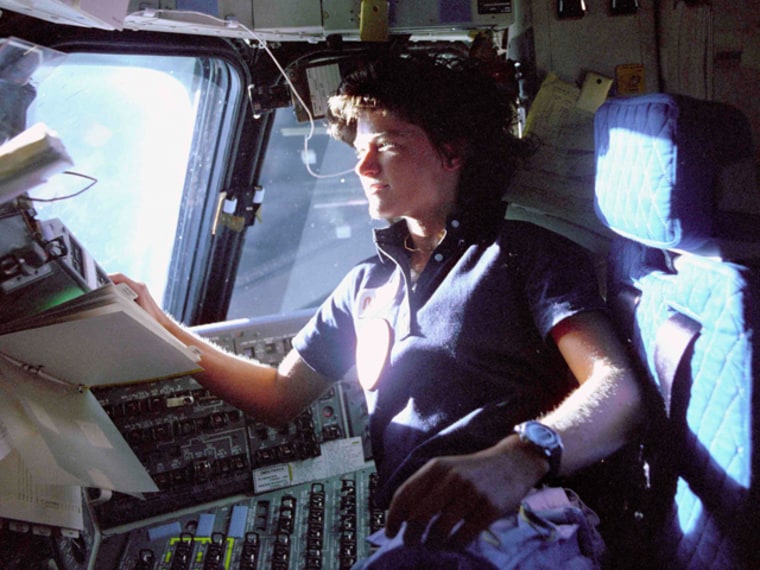The first American woman to go into space, Sally Ride, died Monday after a 17-month battle against pancreatic cancer, her company said.
Ride made history in 1983 as a crew member on the space shuttle Challenger, breaking the gender barrier for U.S. spaceflight. Soviet cosmonaut Valentina Tereshkova became the first woman in space in 1963, but it took another 20 years for NASA to follow suit.
Word of Ride's death came in an announcement from Sally Ride Science, the educational venture she founded after leaving NASA.
President Barack Obama said he and his wife, Michelle, were "deeply saddened" by the news.
"As the first American woman to travel into space, Sally was a national hero and a powerful role model," Obama said in a White House statement. "She inspired generations of young girls to reach for the stars, and later fought tirelessly to help them get there by advocating for a greater focus on science and math in our schools. Sally’s life showed us that there are no limits to what we can achieve, and I have no doubt that her legacy will endure for years to come."
NASA's leaders issued tributes as well.
"Sally Ride broke barriers with grace and professionalism — and literally changed the face of America's space program," NASA Administrator Charles Bolden said. "The nation has lost one of its finest leaders, teachers and explorers. Our thoughts and prayers are with Sally's family and the many she inspired. She will be missed, but her star will always shine brightly."
NASA's deputy administrator, Lori Garver, said Ride "was a personal and professional role model to me and thousands of women around the world."
"Her spirit and determination will continue to be an inspiration for women everywhere," Garver said.
Huge expectations
Ride was a mission specialist on her first mission, STS-7, which put the Canadian Anik C-2 and the Indonesian Palapa B-1 communication satellites into orbit. In an 2008 interview timed to coincide with the 25th anniversary of the flight, Ride acknowledged that her status as the first American woman "carried huge expectations along with it."
"I didn't really think about it that much at the time ... but I came to appreciate what an honor it was to be selected to be the first to get a chance to go into space," she said.
Thousands of spectators wore T-shirts and buttons emblazoned with the slogan "Ride, Sally, Ride" on launch day.
Ride made a second space shuttle flight in 1984, also aboard Challenger, and was in training for her third mission when Challenger exploded in 1986, killing all seven crew members. She left the space agency a year later, and served for years as a physics professor and director of the California Space Institute.
In 2001, she founded Sally Ride Science, a which is aimed at promoting math and science for girls. One of her projects was to develop a camera that could fly aboard spacecraft and take pictures for middle-school students. The fruits of those efforts include EarthKAM on the International Space Station and MoonKAM on the GRAIL lunar probes.
"What might seem like just a cool activity for these kids may very well have a profound impact on their futures," Ride said after the first student-requested MoonKAM pictures were released in March of this year.
Investigated two tragedies
Ride was the only person to serve on both of the investigative boards for NASA's two shuttle tragedies, the Challenger explosion as well as the 2003 loss of Columbia and its crew. She was also a member of the commission that laid out space policy options for the Obama administration in 2009. That panel's conclusions led the White House to cancel a plan to send astronauts back to the moon, known as the Constellation program, and instead set the nation's sights on exploring near-Earth asteroids, leading eventually to missions to Mars.
When the commission completed its report, Ride bristled over the limitations that NASA's exploration efforts faced. "This budget is just simply not friendly to exploration," she said. "It's very difficult to find an exploration scenario that actually fits within this very restrictive budget guidance that we've been given."
The announcement of Ride's death noted that she is survived by her partner of 27 years, Tam O'Shaughnessy, who is the chief operating officer and executive vice president for content at Sally Ride Science. Other survivors include her mother, Joyce; her sister, Bear; her niece, Caitlin; and her nephew, Whitney. Ride was married to fellow astronaut Steven Hawley in 1982, but they divorced in 1987 with no children.
Hawley, who is now a professor of physics and astronomy at the University of Kansas at Lawrence, remembered Ride in a NASA statement as "a very private person who found herself a very public persona."
"While she never enjoyed being a celebrity, she recognized that it gave her the opportunity to encourage children, particularly young girls, to reach their full potential," Hawley said. "Sally Ride, the astronaut and the person, allowed many young girls across the world to believe they could achieve anything if they studied and worked hard. I think she would be pleased with that legacy."
